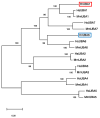Involvement in Fertilization and Expression of Gamete Ubiquitin-Activating Enzymes UBA1 and UBA6 in the Ascidian Halocynthia roretzi
- PMID: 37445840
- PMCID: PMC10341865
- DOI: 10.3390/ijms241310662
Involvement in Fertilization and Expression of Gamete Ubiquitin-Activating Enzymes UBA1 and UBA6 in the Ascidian Halocynthia roretzi
Abstract
The extracellular ubiquitin-proteasome system is involved in sperm binding to and/or penetration of the vitelline coat (VC), a proteinaceous egg coat, during fertilization of the ascidian (Urochordata) Halocynthia roretzi. It is also known that the sperm receptor on the VC, HrVC70, is ubiquitinated and degraded by the sperm proteasome during the sperm penetration of the VC and that a 700-kDa ubiquitin-conjugating enzyme complex is released upon sperm activation on the VC, which is designated the "sperm reaction". However, the de novo function of ubiquitin-activating enzyme (UBA/E1) during fertilization is poorly understood. Here, we show that PYR-41, a UBA inhibitor, strongly inhibited the fertilization of H. roretzi. cDNA cloning of UBA1 and UBA6 from H. roretzi gonads was carried out, and their 3D protein structures were predicted to be very similar to those of human UBA1 and UBA6, respectively, based on AlphaFold2. These two genes were transcribed in the ovary and testis and other organs, among which the expression of both was highest in the ovary. Immunocytochemistry showed that these enzymes are localized on the sperm head around a mitochondrial region and the follicle cells surrounding the VC. These results led us to propose that HrUBA1, HrUBA6, or both in the sperm head mitochondrial region and follicle cells may be involved in the ubiquitination of HrVC70, which is responsible for the fertilization of H. roretzi.
Keywords: E1; FAT10; UBA; ascidian; fertilization; ubiquitin; ubiquitin-activating enzyme.
Conflict of interest statement
The authors declare no conflict of interest.
Figures







Similar articles
-
Extracellular ubiquitin system implicated in fertilization of the ascidian, Halocynthia roretzi: isolation and characterization.Dev Biol. 2003 Dec 1;264(1):299-307. doi: 10.1016/j.ydbio.2003.07.016. Dev Biol. 2003. PMID: 14623250
-
Extracellular ubiquitination and proteasome-mediated degradation of the ascidian sperm receptor.Proc Natl Acad Sci U S A. 2002 Feb 5;99(3):1223-8. doi: 10.1073/pnas.032389499. Epub 2002 Jan 29. Proc Natl Acad Sci U S A. 2002. PMID: 11818546 Free PMC article.
-
Sperm proteases and extracellular ubiquitin-proteasome system involved in fertilization of ascidians and sea urchins.Adv Exp Med Biol. 2014;759:1-11. doi: 10.1007/978-1-4939-0817-2_1. Adv Exp Med Biol. 2014. PMID: 25030757 Review.
-
Ascidian sperm lysin system.Zoolog Sci. 2002 Feb;19(2):139-51. doi: 10.2108/zsj.19.139. Zoolog Sci. 2002. PMID: 12012776 Review.
-
Involvement of Metalloproteases in the Fertilization of the Ascidian Halocynthia roretzi.Biomolecules. 2024 Nov 22;14(12):1487. doi: 10.3390/biom14121487. Biomolecules. 2024. PMID: 39766195 Free PMC article.
References
-
- Schwartz A.L., Ciechanover A. The ubiquitin-proteasome pathway and pathogenesis of human diseases. Annu. Rev. Biochem. 1999;50:57–74. - PubMed
MeSH terms
Substances
LinkOut - more resources
Full Text Sources
Research Materials
Miscellaneous

